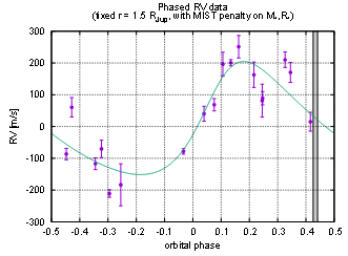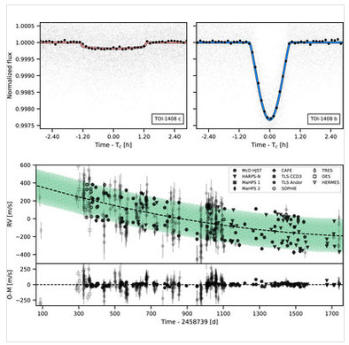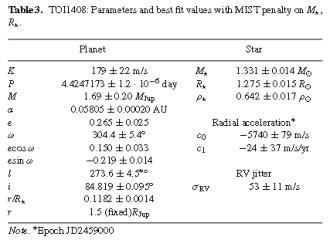
© Special Astrophysical Observatory of the Russian Academy of Sciences
News
TOI-1408:
Discovery
and
Photodynamical
Modeling
of
a
Small
Inner
Companion
to
a
Hot
Jupiter Revealed by Transit Timing Variations
In Korth J., Chaturvedi P., Parviainen H., Carleo I., Endl M., Guenther E.~W., Nowak G., et al., 2024, ApJL, 971, L28. (doi:10.3847/2041-8213/ad65fd) authors reported the discovery and characterization of a small planet, TOI-1408c, on a 2.2 day orbit located interior to a previously known hot Jupiter, TOI-1408b (P = 4.42 days, M = 1.86 ± 0.02 M_Jup, R = 2.4 ± 0.5 R_Jup) that exhibits grazing transits. The two planets are near 2:1 period commensurability, resulting in significant transit timing variations (TTVs) for both planets and transit duration variations for the inner planet. The TTV amplitude for TOI-1408_c is 15% of the planet's orbital period, marking the largest TTV amplitude relative to the orbital period measured to date. Photodynamical modeling of ground-based radial velocity (RV) observations and transit light curves obtained with the Transiting Exoplanet Survey Satellite and ground-based facilities leads to an inner planet radius of 2.22 ± 0.06 R⊕ and mass of 7.6 ± 0.2 M⊕ that locates the planet into the sub-Neptune regime. The proximity to the 2:1 period commensurability leads to the libration of the resonant argument of the inner planet. The RV measurements support the existence of a third body with an orbital period of several thousand days. This discovery places the system among the rare systems featuring a hot Jupiter accompanied by an inner low-mass planet.Doppler
confirmation
of
TESS
planet
candidate
TOI-1408.01
(TOI-1408b):
grazing
transit
and
likely eccentric orbit
In Galazutdinov G.A., Baluev R.V., Valyavin G., Aitov V., Gadelshin D., Valeev A., Sendzikas E., et al., 2023, MNRAS, 526, L111. (doi:10.1093/mnrasl/slad12) and 2024, MNRAS, 531, L33, (doi:10.1093/mnrasl/slae027) we reported an independent Doppler confirmation of the TESS planet candidate orbiting an F-type main-sequence star TOI-1408 located 140 pc away. We presented a set of radial velocities obtained with a high-resolution fibre-optic spectrograph FFOREST. Our self-consistent analysis of these Doppler data and TESS photometry suggests a grazing transit such that the planet obscures its host star by only a portion of the visible disc. Because of this degeneracy, the radius of TOI-1408.01 appears ill-determined with lower limit about ~1 R_Jup, significantly larger than in the current TESS solution. We also derive the planet mass of 1.69 ± 0.20 M_Jup and the orbital period ~4.425d, thus making this object a typical hot Jupiter, but with a significant orbital eccentricity of 0.259 ± 0.026. Our solution may suggest that the planet is likely to experience a high tidal eccentricity migration at the stage of intense orbital rounding, or may indicate possible presence of other unseen companions in the system, yet to be detected.



